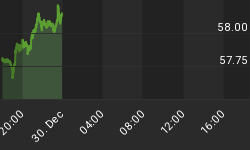Gold is in a classic buying area, it's recent sharp decline having halted exactly at its 200-day moving average and in a zone of strong support. We had expected it to drop to this zone, but to take probably a month or two to do so, instead it has arrived here in the space of a couple of weeks. Many investors have understandably been rattled by the speed of this descent, especially those who read a recent article saying that gold had a parabolic rise, has topped out and will now have an equal parabolic descent. Those who read this article and perhaps believed it will no doubt be relieved to learn that the same author posted an article last October calling a top in gold $250 below the recent peak. Gold did have a parabolic ascent, but not a large one as we will see lower down the page when we examine a very long-term chart, and it has now corrected the excess resulting from that rapid advance.
There is a scenario that we would be wise not to ignore that could result in gold continuing to retreat, but it is a rather extreme one that would involve a steep rise in interest rates and probably a rise in the dollar at the same time. For this reason it is considered sensible to have fairly close stops below existing positions or new purchases now or in the near future - a logical place would be beneath last weeks low. Remember, even if you get stopped out and the picture subsequently improves, you can always climb aboard again, and won't have missed much.
What is believed to have happened last week is that, after a steep decline, we witnessed a classic example of "capitulation" where weak hands lose their nerve and throw in the towel.

On our 1-year chart we can see how the final capitulative selloff does not look so alarming with the benefit of a couple of days of stabilisation and recovery behind us. Just looking at this chart gold appears to be at the absolute classic "buy spot", something you normally have to wait months for. On the face of it it has it all - it has reacted back to its 200-day moving average, and it is way below its 50-day moving average, deeply oversold and is currently just above a zone of strong support. It should be pointed out, however, that it is not likely to go straight back up from here. The vicious plunge last week took its toll on sentiment and so gold is likely to thrash around for a while forming a base area, probably between about $540 and $590, which may continue for some weeks or even a month or two, which will will allow the 50-day moving average to drop down towards the 200-day. Any retreat towards $550 short-term will be regarded as a major buying opportunity, which will have the advantage that a fairly close stop can be employed to limit downside.

Now to examine the so-called parabolic rise in gold, and to put in perspective, and there is no better way to do this than by looking at a very long-term chart for gold going way back to the early 70's. On this chart we can that the recent strong rise in gold looks modest compared to the spike of the late 70's, and when you factor in inflation and therefore take on board the fact that gold would have to attain a price of $2000 an ounce to equal 1979's peak, you quickly realize that any assertion that gold's recent peak was an unsustainable, unexceedable extreme is nonsense. Sure, it MAY have topped out, if the high interest rate and dollar scenario becomes reality, and we have taken account of this, but the recent peak certainly doesn't look that wild on this chart - it only got $220 above its 1983 and 1987 peaks at $500!
Gold stocks are another story, because of the continuing danger of a general stockmarket meltdown, which would be expected to take down pretty much all sectors with it. However, with the strong rally in the broad market last week this danger appears to have been averted for now, so that gold stocks should recover significantly in the near-term. During the recent retreat, some stocks exhibited decidedly bearish volume patterns, notably Goldcorp and the big silvers, we will therefore adopt a more cautious approach with stock themselves while this danger persists.
















